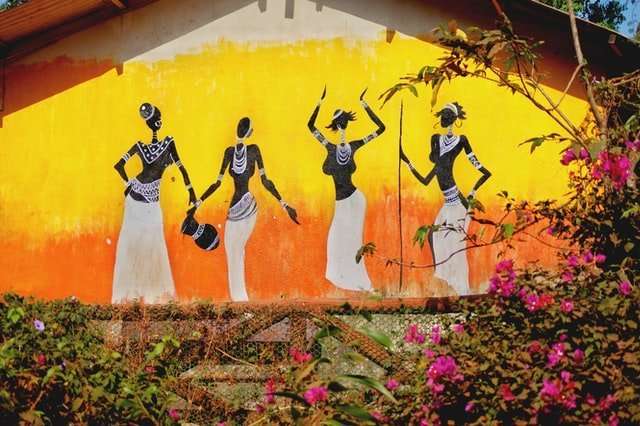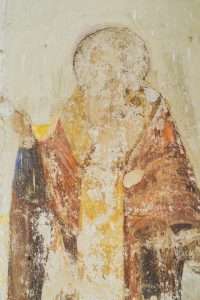Folk art is the art of a particular group: a town, a church, a region, or even an entire country.
In America, folk art encompasses a wide range of styles and techniques. You can think of it as anything created by ordinary people that doesn’t fall into the mainstream categories of fine art. It includes paintings, sculpture, quilts, woodwork, and much more.
The term “folk art” was first used in the nineteenth century by artists and collectors who wanted to distinguish traditional art made outside the structured fine arts world from professionally produced artwork. A good example is the work of Edward Hicks (1780-1849). He was a Quaker minister who made his living as a portrait painter but who preferred painting religious scenes to portraiture. He “discovered” folk art when he began painting the stories from the Bible using bold colors and simple shapes.*
And there are other examples of what we would now call folk or outsider art within his own family! His daughter Elizabeth (1813-1904) was also very well known for her paintings inspired by Quaker spiritual traditions. In fact she’s known today as the first American woman artist to make a successful career out of her work–back then it was just called “making
The term “folk art” is not used in the art world, but often there’s overlap between what curators of fine art and folk art collectors and dealers collect. If you’re interested in buying or selling, understanding the differences can be challenging.
A few tips on how to select folk art and how to price it:
Folk art is generally defined as art created by self-taught rather than formally trained artists. Sometimes this means that a person who is a professional artist but has not gone to an accredited school is considered folk (most of these artists are actually non-folk). Folk art also includes all the artifacts created by people working in the decorative arts such as basket making, spinning, pottery – anything done by hand.
Also, some artists have deliberately made their work look like folk art. These pieces are sometimes called folk-styled art or faux folk art.
In general, folk art is sold at a fraction of the prices of fine works of similar age, size and materials. The prices for both are determined by condition, sizes and styles (ie genre). Values for both types of art go up with age, but value for fine works goes up exponentially with age while values for folk works go up linearly with age. Condition is
The idea of folk art is a relatively recent one, and in the US it dates back to the 19th century. Art has been made by ordinary people for millennia, but the term “folk art” comes from a time when there was a divide between fine art (which was held to be aristocratic and elitist) and decorative arts (which were considered more democratic). The “folk” — that is, ordinary people — were thought not to have much taste or appreciation for art, so their work was lumped into the category of “folk art.”
The creation of this category reveals as much about the artists who made it as it does about the people they described. It tells us something about how culture is created, who gets to be an artist, and what kinds of art are valued in society. It also points us toward other categories — like primitive art — which we might want to reconsider.
-See more at: http://www.tate.org.uk/learn/online-resources/glossary
Folk art is a term that describes the works of art, usually produced by untrained artists, which have been created and used within their own communities without application to the market economy. The term applies to all forms of popular visual art: drawing, painting, printmaking and sculpture as well as textiles, woodwork and ceramics.
The term “folk art” was coined in 1846 by the Englishman William John Wainwright (1810–1897) who collected works on his travels in Europe, including ‘souvenirs’ from Vienna and Dresden. He formed the opinion that many of these were artistic treasures despite being outside the mainstream of formal academic art. However it was not until the early 20th century that this opinion gained widespread acceptance.
Folk art is a broad term that encompasses any art made by self-taught artists. The word itself is derived from the German Volkskunst, which translates to “the art of the people.” Folk art is quite similar to outsider art; however, folk art generally refers to artwork created within a community, while outsider art refers to works created outside of it by individuals who have not been exposed to formal training or education.
Whether you know it or not, you’ve seen folk art before. For example, the quilts and patchwork made by black slaves in the American South are variations on traditional African textile patterns. Native American beadwork and other handmade crafts are considered folk art as well. However, many people consider the quintessential example to be outsider artist Henry Darger’s 15,000 page opus The Story of the Vivian Girls: What Happened to Seven Little Girls Who Were Raped and Murdered by Henry Darger.
This blog is about all things folk and/or outsider art. From traditional handicrafts like basketry and quilting, to street art and graffiti, we’ll cover them all! We’ll also discuss folk artists’ interactions with contemporary artists – such as Andy Warhol’s controversial use of folk artist Jasper Johns’
Folk art is a broad term that encompasses all of the art made by and for ordinary people. The term is problematic, especially when one attempts to define it. As a result, folk art is often defined in four different ways. These are:
Folk art is art that was created by folk artists, or artists who were not professional artists;
Folk art is art that was created by amateurs or non-specialists. Folk art is also used to describe objects produced in traditional forms;
Folk art is any artwork that embraces specific stylistic characteristics or a traditional style;
Folk art is any artwork that has been created outside of academia.
Folk art is, in a sense, any work of art that is the expression of an untrained, nonprofessional artist. But the word is most often used to describe craft objects made by ordinary people, especially in the past. It is distinguished from fine art, which was produced by trained and professional artists. Many folk art objects were truly made by amateurs who had no formal artistic training; even so, the label “folk art” is usually applied to objects created not just by individuals but by groups of people (often communities) who shared a common tradition and way of life.
The term “folk art” can also be applied to fine arts (such as painting or sculpture) that are closely linked to the crafts. The distinction between folk and fine arts is not always sharp; some folk art has been accepted into mainstream museums as part of world culture. Folk artists often rely on self-taught techniques, whereas professional artists usually train for years in workshops before producing marketable works.
Hobbyists who produce crafts for pleasure rather than financial gain are called craftspeople and may be professional or amateur depending on the amount of time they devote to the practice.
Folk artists typically use traditional forms, techniques, materials and subjects. Traditional folk music includes a


